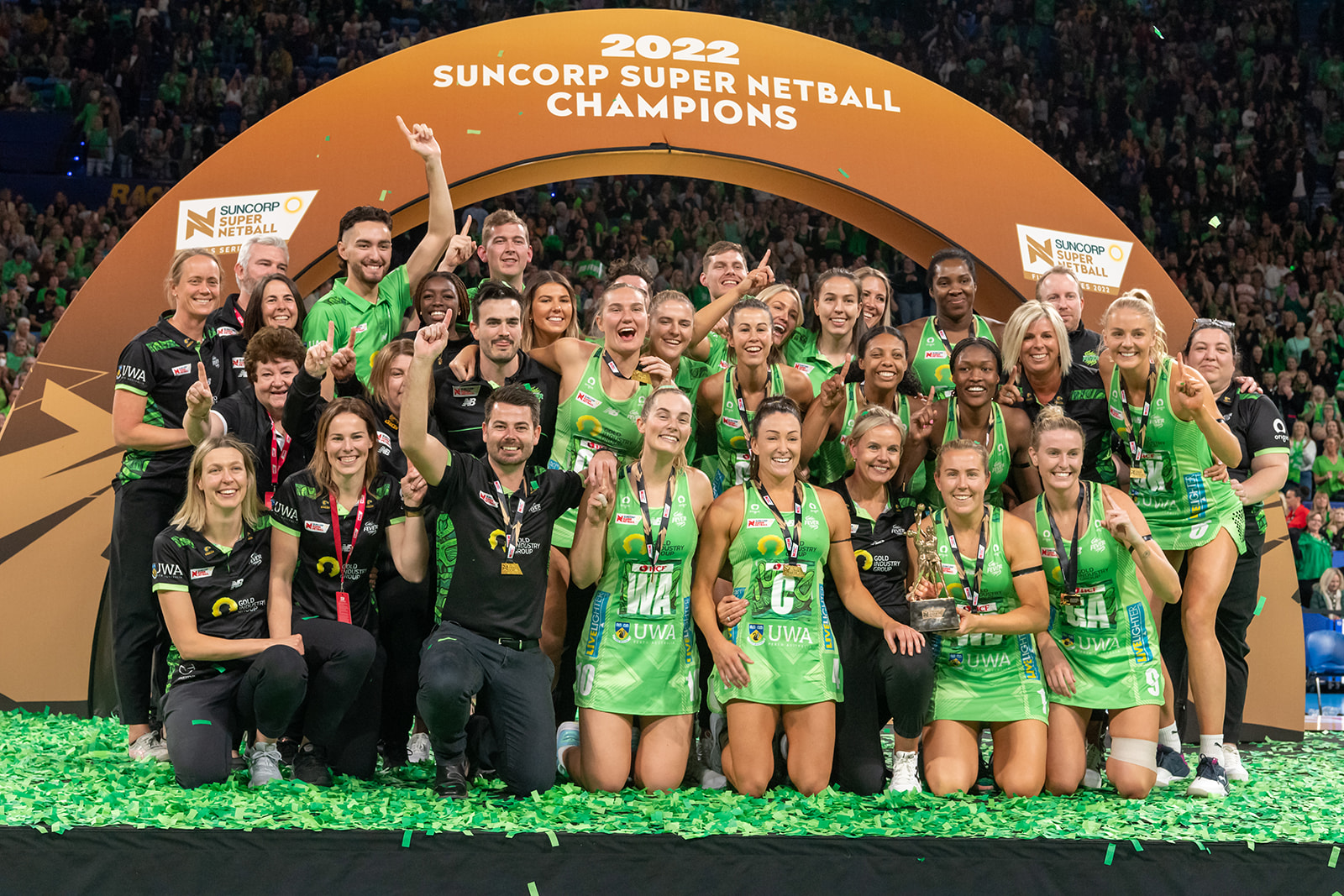
Contributors: Jenny Sinclair, Clinton Bradbury, Ian Harkin.
On a bright sunny day in Perth, with RAC Arena filled to the rafters with stomping, cheering fans, the two best Suncorp Super Netball teams of 2022 faced off in an epic grand final. While the Vixens finished as minor premiers, Fever won the major semi-final in convincing fashion, setting up a final encounter for which few were brave enough to predict an outcome.
A win for either side would produce it’s share of feel good stories – for the Vixens, a riches to rags to riches redemption story, and for the Fever, their first title across their 25 year history, and a raft of individual triumphs.
However, it was Fever who convincingly prevailed, taking the early lead and winning each quarter on their road to victory. And with a redemption story for the coach, the retirement of a beloved teammate, a crucial return from injury, the homesick mother, athletes learning new positions and tactics, for the club stalwarts and new signings, there was plenty to celebrate.
Welcome to Country from Whadjuk-Noongar land. Image Clinton Bradbury/Bradbury Photography
Match Result
West Coast Fever 71 def Melbourne Vixens 59 (18-14, 17-15, 19-16, 16-14)
Let’s Talk
This was a win 25 years in the making. West Coast Fever claimed the 2022 Suncorp Super Netball title after a comprehensive win in the grand final in Perth. Winning all four quarters, Fever proved too good for Melbourne Vixens 71-59. It is the first national league title for the Western Australian club which was first established as the Perth Orioles in 1997.
The grand final was played in front of a record crowd of 13,908 at RAC Arena, so it was a roaring success. Perth people love their sport, especially when the local team is involved. With the decision to sell grand finals and take the matches around the country, it remains to be seen what will happen in future years if the grand final doesn’t feature a local team.
At season’s end, Jhaniele Fowler had final shooting stats of 929/961 at 96.7%. She averaged 58 successful shots per game, which is exactly what she achieved in the grand final. Meanwhile, Liz Watson finished with 405 goal assists at an average of 23.8 per game, and Courtney Bruce ended the season with 107 possession gains at 6.7 per game.
Ahead of the grand final, the Nissan Net Points team of the year was announced. Remembering that NNP is based purely on statistics, not opinion, it was nonetheless interesting to see the selections, with just two of Australia’s Commonwealth Games squad making the final seven.
GS – Jhaniele Fowler
GA – Gretel Bueta
WA – Liz Watson
C – Maddy Proud
WD – Amy Parmenter
GD – Latanya Wilson
GK – Shamera Sterling

Fever applaud as Vixens enter the court. Image Clinton Bradbury/Bradbury Photography
The Road to the Finals
The Vixens were the form team right from the start, winning the Team Girls Cup during the preseason, and dropping just two games across fourteen rounds. They drew confidence by winning from the front, and hunting down leads when in arrears, but their performances became patchier towards the end of the season. With the finals underway, they suffered a blowout loss to the Fever in the major semi, and escaped a ten goal deficit against the Giants in the preliminary final.
Missing Rahni Samason across the middle of the season, following minor knee surgery to their rising star, made it difficult for the Vixens to bed down their shooting circle rotations. Covid also played its role, with players missing at various points of the season.
Fever also struggled for consistency, with crucial midcourter Jess Anstiss missing half the season with a foot injury, and significant outs when the state borders finally opened and Covid ran rampant through the Western Australia. Despite that, they won 10 of their 14 matches, had the best percentage in the league, and found form once they had their contracted 10 players back out on court. Their impressive performance to win the major semi-final saw them go straight through to the main event.

Heart felt hugs. Sue Gaudion and Dan Ryan. Image Clinton Bradbury/Bradbury Photography
Stats Leaders
Most goals – 58/59 Jhaniele Fowler (Fever)
Most assists – 26 Sasha Glasgow (Fever)
Most feeds – 38 Liz Watson (Vixens)
Most centre pass receives – 35 Alice Teague-Neeld (Fever)
Most gains – 8 Courtney Bruce (Fever)
Most intercepts – 2 Jo Weston, Emily Mannix (Vixens)
Most rebounds – 6 Courtney Bruce (Fever)
Most deflections – 7 Courtney Bruce (Fever)
Most turnovers – 7 Verity Simmons (Fever), Liz Watson (Vixens)
Most penalties – 16 Courtney Bruce (Fever)
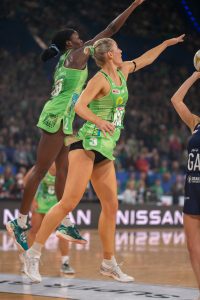
The double jump over the shot. Image Clinton Bradbury/Bradbury Photography
Match Report
Umpires: Tara Warner, Jenna Cook, Bronwen Adams
What worked?
In such a high pressure match, both teams showed incredible composure and settled quickly into the game. Giving up just eight (Fever) and 11 (Vixens) unforced turnovers was a credit to the ball handling ability of both teams.
However, it was the strategic shift by Fever that made them so dominant towards the end of the season, and continued on into the finals. In previous years the main route to goal has been through Verity Simmons, and far too often her ‘lift the ball and hope’ approach has come unstuck.
More recently, the attacking workload has started with Fever’s goal defence and wing defence providing safe and reliable ball carrying options right through to the transverse line. This has allowed Sasha Glasgow and Alice Teague-Neeld to start deeper in attack, and drive towards the ball, rather than the lateral moves or leads away from the ball that are far more likely to result in an intercept.
While the cost of that could be congestion in front of the goal post, Fever have turned it into an artform by spreading their play wide, with a triple pronged attack across the centre and tramlines of the court.
The strategy worked beautifully, and using a range of shorter, safer passes, and the height advantage that a 187cm goal attack and 183cm wing attack offers, Fever moved the ball patiently towards goal. The Vixens’ immense hands-over pressure – which has long been a hallmark of their game – did produce some handling errors by Teague Neeld and Simmons who gave up 13 turnovers between them.
However, Teague-Neeld dominated with 35 centre pass receives, and it was her immediate short pass off to Simmons (24 second phase receives) that gave the Fever attack line time to set up their structures.
Unfortunately for the Vixens they spent too much time on the body trying to break down Fever’s attacking connections, giving away 79 penalties to the Fever’s 55. Vixens’ penalties were split relatively evenly across their entire team, with goal attack through to goal keeper all ending up in the double digits.
Fever’s defensive strategy was one for the books, changing constantly and not allowing the Vixens attack to settle into routine. The defenders sat off the body for the most part, wiping the top of the circle and forcing the Vixens attackers wide. Simmons and Anstiss were quick to position themselves circle side of the ball, reducing access to prime feeding position, while Aryang’s speed saw her float around the circle to shut down space, slow play, and allow Bruce time to hunt the ball.
Austin and Watson had some beautiful passages of play, particularly when they found space to drive into, but their combined 11 errors in attack came at costly moments. And while Kumwenda tried to fire up her side, she didn’t appear to be quite her usual feisty self, and her opportunities to post were limited.

Pause for thought and some tactical discussion – Sasha Glasgow and coach Dan Dyan. Image Clinton Bradbury/Bradbury Photography
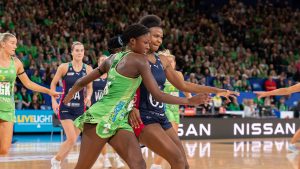
Mwai Kumwenda was quiet by her usual standards, with Sunday Aryang providing some close marking. Image Clinton Bradbury/Bradbury Photography
Where the match was won and lost?
With Vixens able to hunt down margins through the supershot, it wasn’t until late in the fourth quarter that the game finally appeared to be out of reach.
However, Fever slowly but steadily built a lead across the match, and the second and third quarters were crucial to their success. With the Vixens giving away 44 penalties during that thirty minute period, to the Fever’s more miserly 23, they were out of play far too often, and lacked the ability to build defensive and strategic pressure on the opposition. The midcourters were equally as guilty as the defenders with Austin (10), Watson (10) and Moloney (11) matching Eddy (12), Weston (14) and Mannix (11).

Sasha Glasgow passes off to the waiting Jhaniele Fowler, while Em Mannix stands out of play. Image Clinton Bradbury/Bradbury Photography
Which players/combinations stood out?
Fever’s win was crafted on the back of sixty minute’s worth of discipline by the entire team. Each athlete understood their role, and played it to perfection, made somewhat easier by their comfortable lead in the closing stages of the game. It was hard to find any individual winners on the day for the Vixens, and while they battled to the end, too many penalties and some costly errors in attack were the story of their match.
Fever’s strategy of spreading the attack was crucial to their success with Teague-Neeld (34 feeds), Simmons (34 feeds) and Glasgow (28 feeds) all sharing the workload. With the ball coming into the circle from all angles, it was challenging for the Vixens to settle into their regular defensive structures. In contrast, Watson’s 38 feeds compared to Moloney’s 19 and Austin’s 15, made Watson the obvious target for Fever’s defence.
In team based metrics, Fever also had the edge. They converted 84% of their centre passes compared to the Vixens 73%, and 64% of unforced turnovers compared to just a 25% success rate by the Vixens.

Kate Moloney kept her workrate up across the game, as she went head to head with Verity Simmons. Image Clinton Bradbury/Bradbury Photography
The Match-ups
Fever GS v Vixens GK
Jhaniele Fowler is so good, that she doesn’t always receive the credit she deserves, but turned in a magnificent performance in the grand final. Despite a few nerves at the start, she shot 58/59, cleaned up four rebounds, and pulled in a range of balls despite being frequently double-teamed. Emily Mannix and Liv Lewis were both tried against her, and despite staying on their toes, had limited impact against the shooting superstar.
Fever GA v Vixens GD
Sasha Glasgow has built across the season as she’s bedded down not only the move to goal attack, but turning in a 60 minute performance. In the grand final, she earned the MVP for her work out the front of Fowler. Sharing feeding duties equally with her midcourters, Glasgow was always on for the pass, and enough of a threat in the circle that she drew the defenders off Fowler. While her accuracy wasn’t convincing at 8/13, Glasgow had just one ball handling error for the match.
Jo Weston and Kate Eddy were both used against her, coming up with three gains but too many penalties between them. Weston was the Vixens best, but lacked support.
Fever WA v Vixens WD
One of coach Dan Ryan’s masterstrokes this season has been moving Alice Teague-Neeld to wing attack. A crafty, court-wise player, she’s also built into the season, and was regularly available on the centre pass (35 for the match) and as a short, sharp passing option. At 183cm her height helps with her vision down court, and she’s also stepped up defensively.
Kate Eddy had few answers against Teague-Neeld, and got caught on the body too much, giving away cheap penalties that reduced her defensive pressure.
Fever C v Vixens C
Verity Simmons and Kate Moloney went toe to toe right across the match. While Moloney gave up just two turnovers compared to Simmons seven, she didn’t have the same ability to feed her shooting circle, returning just 19 to Simmon’s 34. And with Watson having less than her usual impact, Moloney needed a better return.
Simmon’s performance showed how disciplined she has been of late – trusting that she and her teammates can work the ball closer to Fowler for a lower-risk offload, rather than turning, putting the ball up, and hoping.
Fever WD v Vixens WA
In one of the most pivotal battles of the game, the Liz Watson and Jess Anstiss matchup was a treat. While Watson returned some fine figures (38 feeds, 20 centre pass receives), it was a less dominant display than we are used to seeing from the Vixens’ co-captain. Anstiss worked overtime to keep Watson away from her preferred feeding position on the circle edge, while being a constant option in attack.
It was a gritty defensive effort from Anstiss, who is still battling a foot injury that will need further off-season management.
Fever GD v Vixens GA
Eyes were on Kiera Austin as she returned from Covid, and she was among Vixens’ best, with some beautifully timed circle sweeps and baseline drives and 21/27 shots, many from range. However, the lack of court time with substitute Rahni Samason showed, as the pair struggled with fluency when Kumwenda was benched.
In a strategy that reaped rewards in the major semi-final, Sunday Aryang sat off Austin and hovered back in the circle. While she didn’t win any clean ball, her presence helped to confuse the space for the feeders, and allowed Courtney Bruce more room to fly at the ball. When Aryang left the court with cramping, Stacey Francis-Bayman didn’t ease off the pressure.
Fever GK v Vixens GS
From the opening whistle, Courtney Bruce attacked any balls that came near her, finishing with eight gains, of which six were perfectly timed, boxed out rebounds. Despite being the most penalised player on court (16 penalties), Bruce’s ball hunting ability also challenged the opposition feeders.
Mwai Kumwenda was accurate, but at 28/31 lacked the volume that the Vixens needed. Rahni Samason was injected into the game a couple of times, and while she wasn’t afraid to go to the post, her combination with Austin didn’t look comfortable.
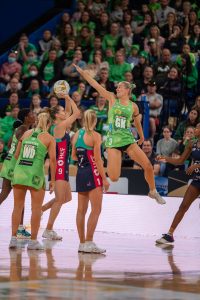
Kiera Austin stood up under the pressure of the Fever defence and her return from Covid. Image Clinton Bradbury/Bradbury Photography

Sasha Glasgow down but not out. Image Clinton Bradbury/Bradbury Photography
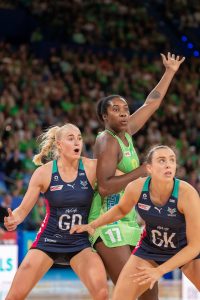
Some close checking by Jo Weston and Liv Lewis didn’t slow Jhaniele Fowler down for long. Image Clinton Bradbury/Bradbury Photography
Shooting statistics
FEVER:
Jhaniele Fowler 58/59 (98%)
Sasha Glasgow 8/13 (62%)
TOTAL 66/72 (92%)
VIXENS:
Mwai Kumwenda 28/31 (90%)
Kiera Austin 21/27 (78%)
Rahni Samason 4/6 (67%)
TOTAL 53/64 (83%)
MVP: Sasha Glasgow (Fever)

Sasha Glasgow couldn’t quite believe her MVP. Image Clinton Bradbury/Bradbury Photography
2022 Finishing Positions
1 – West Coast Fever
2 – Melbourne Vixens
3 – GIANTS Netball
4 – Collingwood Magpies
5 – NSW Swifts
6 – Queensland Firebirds
7 – Adelaide Thunderbirds
8 – Sunshine Coast Lightning
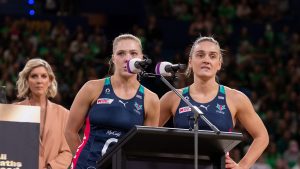
A sombre Kate Moloney and Liz Watson after the match. Image Clinton Bradbury/Bradbury Photography

MVP Sasha Glasgow has playing some of her best netball since moving to Perth. Image Clinton Bradbury/Bradbury Photography

Smiles all round. Image Clinton Bradbury/Bradbury Photography

Fever’s training partners. Image Clinton Bradbury/Bradbury Photography

Stacey Francis-Bayman in what was later revealed to be her last game for Fever. Image Clinton Bradbury/Bradbury Photography

Post match interviews with a tired but content captain and coach. Image Clinton Bradbury/Bradbury Photography
